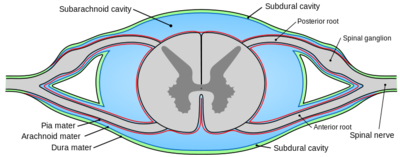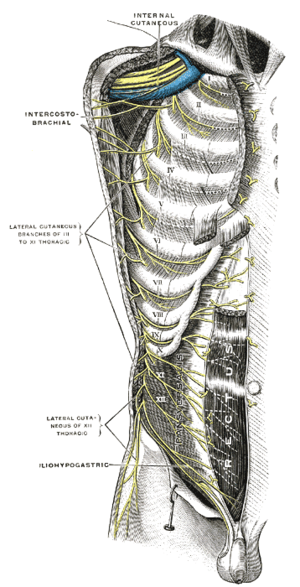Thoracic Spinal Nerves: Difference between revisions
No edit summary |
No edit summary |
||
| Line 1: | Line 1: | ||
<div class="editorbox"> | <div class="editorbox"> | ||
'''Original Editor '''- | '''Original Editor '''- Lucinda hampton | ||
'''Top Contributors''' - {{Special:Contributors/{{FULLPAGENAME}}}} | '''Top Contributors''' - {{Special:Contributors/{{FULLPAGENAME}}}} | ||
</div> | </div> | ||
== Introduction == | == Introduction == | ||
[[File: | [[File:Interactive Spine - Thoracic Vertebral Spine - L7F22.jpg|right|frameless]]The [[Thoracic Anatomy|thoracic spine]] has 12 nerve roots (T1 to T12) on each side of the spine that branch from the [[Spinal cord anatomy|spinal cord]] and control motor and sensory signals mostly for the upper back, chest, and [[Abdominal Muscle Anatomy|abdomen]].<ref name=":0">Spine Health [https://www.spine-health.com/conditions/upper-back-pain/thoracic-spinal-nerves Thoracic Spinal Nerves] Available from:https://www.spine-health.com/conditions/upper-back-pain/thoracic-spinal-nerves (last accessed 7.5.2020)</ref> | ||
The thoracic spine has 12 nerve roots (T1 to T12) on each side of the spine that branch from the spinal cord and control motor and sensory signals mostly for the upper back, chest, and abdomen.<ref name=":0">Spine Health [https://www.spine-health.com/conditions/upper-back-pain/thoracic-spinal-nerves Thoracic Spinal Nerves] Available from:https://www.spine-health.com/conditions/upper-back-pain/thoracic-spinal-nerves (last accessed 7.5.2020)</ref> | |||
Each thoracic spinal nerve is named for the vertebra above it. eg the T4 nerve root runs between the T4 vertebra and T5 vertebra. | Each thoracic spinal nerve is named for the vertebra above it. eg the T4 nerve root runs between the [[Thoracic Vertebrae|T4 vertebra]] and T5 vertebra. | ||
There are 12 thoracic spinal nerve root pairs (two at each thoracic vertebral level), starting at vertebral level T1-T2 and going down to T12-L1. | There are 12 thoracic spinal nerve root pairs (two at each thoracic vertebral level), starting at vertebral level T1-T2 and going down to T12-L1. | ||
=== Function === | === Function === | ||
* | *Each thoracic nerve root exits the spinal canal through an intervertebral foramen (formed by two adjacent vertebrae, and its size and shape can slightly shift as the vertebrae move). | ||
* After branching from the spinal cord and traveling through the foramen, a thoracic nerve root branches into two different nerve bundles that feed into the rami ie ventral ramus and dorsal ramus. | * After branching from the spinal cord and traveling through the foramen, a thoracic nerve root branches into two different nerve bundles that feed into the rami ie ventral ramus and dorsal ramus. | ||
At the T1 through T11 levels: | At the T1 through T11 levels: | ||
[[File:Cross section spinal cord.png|right|frameless|400x400px]] | |||
* Ventral ramus - Eleven of them are situated between the ribs, and are therefore termed intercostal; the twelfth lies below the last rib. Each nerve is connected with the adjoining ganglion of the sympathetic trunk by a gray and a white ramus communicans. | * Ventral ramus - Eleven of them are situated between the ribs, and are therefore termed intercostal; the twelfth lies below the last rib. Each nerve is connected with the adjoining ganglion of the sympathetic trunk by a gray and a white ramus communicans. | ||
* Dorsal ramus go into the back muscles and also provides sensation to the skin. | * Dorsal ramus go into the back muscles and also provides sensation to the skin. | ||
| Line 28: | Line 26: | ||
Each spinal nerve carries both sensory and motor information, via efferent and afferent nerve fibers - ultimately via the motor cortex in the parietal cortex - but also through the phenomenon of reflex. Spinal nerves are referred to as “mixed nerves.” | Each spinal nerve carries both sensory and motor information, via efferent and afferent nerve fibers - ultimately via the motor cortex in the parietal cortex - but also through the phenomenon of reflex. Spinal nerves are referred to as “mixed nerves.” | ||
* In the thoracic region they remain distinct from each other and each innervates a narrow strip of muscle and skin along the sides, chest, ribs, and abdominal wall. These rami are called the intercostal nerves (in regions other than the thoracic, ventral rami converge with each other to form networks of nerves called nerve plexuses).<ref name=":1" /> | * In the thoracic region they remain distinct from each other and each innervates a narrow strip of muscle and skin along the sides, chest, ribs, and abdominal wall. These rami are called the intercostal nerves (in regions other than the thoracic, ventral rami converge with each other to form networks of nerves called nerve plexuses).<ref name=":1" /> | ||
The meningeal branches (recurrent meningeal or sinuvertebral nerves) branch from the spinal nerve and re-enter the intervertebral foramen to serve the ligaments, dura, blood vessels, intervertebral discs, facet joints, and periosteum of the vertebrae.<ref name=":2">lumenlearning [https://courses.lumenlearning.com/boundless-ap/chapter/spinal-nerves/ spinal nerves] Available from:https://courses.lumenlearning.com/boundless-ap/chapter/spinal-nerves/ (last accessed 7.5.2020)</ref> | |||
Actions of the Thoracic spinal Nerves<ref name=":2" /> | |||
{| class="wikitable" | |||
|T1–T6 | |||
|Intercostals and trunk above the waist | |||
|- | |||
|T7–L1 | |||
|Abdominal muscles | |||
|} | |||
=== Rami === | === Rami === | ||
| Line 39: | Line 47: | ||
* The medial branches (ramus medialis; internal branch) of the posterior divisions supply Semispinalis dorsi and Multifidus, Longissimus dorsi. | * The medial branches (ramus medialis; internal branch) of the posterior divisions supply Semispinalis dorsi and Multifidus, Longissimus dorsi. | ||
* The lateral branches (ramus lateralis; external branch) supply Longissimus dorsi, Iliocostales. the skin of the buttock.<ref name=":1">Imaios [https://www.imaios.com/en/e-Anatomy/Anatomical-Parts/Thoracic-nerves-T1-T12 Thoracic Nerves] Available from: https://www.imaios.com/en/e-Anatomy/Anatomical-Parts/Thoracic-nerves-T1-T12 (last accessed 7.5.2020)</ref> | * The lateral branches (ramus lateralis; external branch) supply Longissimus dorsi, Iliocostales. the skin of the buttock.<ref name=":1">Imaios [https://www.imaios.com/en/e-Anatomy/Anatomical-Parts/Thoracic-nerves-T1-T12 Thoracic Nerves] Available from: https://www.imaios.com/en/e-Anatomy/Anatomical-Parts/Thoracic-nerves-T1-T12 (last accessed 7.5.2020)</ref> | ||
== Clinical relevance == | == Clinical relevance == | ||
| Line 50: | Line 52: | ||
1.[[Thoracic Disc Syndrome|Thoracic herniated disc,]] leading to [[Thoracic Radiculopathy|thoracic radiculopathy]], with symptoms of pain, tingling, numbness, and/or weakness radiating along the nerve root. | 1.[[Thoracic Disc Syndrome|Thoracic herniated disc,]] leading to [[Thoracic Radiculopathy|thoracic radiculopathy]], with symptoms of pain, tingling, numbness, and/or weakness radiating along the nerve root. | ||
* These symptoms typically follow a pattern as noted above, based on the affected nerve root’s location and functions. eg, T3 [[radiculopathy]] could radiate pain and other symptoms into the chest via the branch of the nerve root that becomes an intercostal nerve traveling along the route between the third and fourth ribs. If the branch of the thoracic nerve going toward the back becomes inflamed, pain and other symptoms could be felt in the back at or near the location of the inflammation<ref name=":0" />. | *[[File:Sam-burriss-zHSX9o2 B7Y-unsplash.jpg|right|frameless|300x300px]]These symptoms typically follow a pattern as noted above, based on the affected nerve root’s location and functions. eg, T3 [[radiculopathy]] could radiate pain and other symptoms into the chest via the branch of the nerve root that becomes an intercostal nerve traveling along the route between the third and fourth ribs. If the branch of the thoracic nerve going toward the back becomes inflamed, pain and other symptoms could be felt in the back at or near the location of the inflammation<ref name=":0" />. | ||
2. A severe strain of a muscle between ribs (intercostal muscle) or a [[Slipping rib syndrome|slipping rib]], can cause an intercostal nerve to become inflamed, painful, and possibly make breathing more difficult and certain movements painful. | 2. A severe strain of a muscle between ribs (intercostal muscle) or a [[Slipping rib syndrome|slipping rib]], can cause an intercostal nerve to become inflamed, painful, and possibly make breathing more difficult and certain movements painful. | ||
| Line 56: | Line 58: | ||
* Spinal cord injuries are usually classified based on the spinal nerve root level where function is reduced or completely lost. For example, a T6 spinal cord injury would impair or lose function at the T6 nerve root level and below. In this case, the person would likely have full use of the arms and breathing ability, but may have weakness, numbness, and other problems in the abdominal area and below, such as paralysis of both legs and bowel/bladder dysfunction. | * Spinal cord injuries are usually classified based on the spinal nerve root level where function is reduced or completely lost. For example, a T6 spinal cord injury would impair or lose function at the T6 nerve root level and below. In this case, the person would likely have full use of the arms and breathing ability, but may have weakness, numbness, and other problems in the abdominal area and below, such as paralysis of both legs and bowel/bladder dysfunction. | ||
== References == | |||
== References | |||
<references /> | <references /> | ||
| Line 68: | Line 64: | ||
[[Category:Anatomy]] | [[Category:Anatomy]] | ||
[[Category:Nerves]] | [[Category:Nerves]] | ||
[[Category:Thoracic Spine]] | |||
[[Category:Thoracic Spine - Nerves]] | |||
Revision as of 08:20, 7 May 2020
Original Editor - Lucinda hampton
Top Contributors - Lucinda hampton and Kim Jackson
Introduction[edit | edit source]
The thoracic spine has 12 nerve roots (T1 to T12) on each side of the spine that branch from the spinal cord and control motor and sensory signals mostly for the upper back, chest, and abdomen.[1]
Each thoracic spinal nerve is named for the vertebra above it. eg the T4 nerve root runs between the T4 vertebra and T5 vertebra.
There are 12 thoracic spinal nerve root pairs (two at each thoracic vertebral level), starting at vertebral level T1-T2 and going down to T12-L1.
Function[edit | edit source]
- Each thoracic nerve root exits the spinal canal through an intervertebral foramen (formed by two adjacent vertebrae, and its size and shape can slightly shift as the vertebrae move).
- After branching from the spinal cord and traveling through the foramen, a thoracic nerve root branches into two different nerve bundles that feed into the rami ie ventral ramus and dorsal ramus.
At the T1 through T11 levels:
- Ventral ramus - Eleven of them are situated between the ribs, and are therefore termed intercostal; the twelfth lies below the last rib. Each nerve is connected with the adjoining ganglion of the sympathetic trunk by a gray and a white ramus communicans.
- Dorsal ramus go into the back muscles and also provides sensation to the skin.
The motor and sensory functions provided by a thoracic nerve root are determined by its vertebral level. These functions can slightly vary from person to person but typically are as follows:
- T1 and T2 (top two thoracic nerves) feed into nerves that go into the top of the chest as well as into the arm and hand.
- T3, T4, and T5 feed into the chest wall and aid in breathing.
- T6, T7, and T8 can feed into the chest and/or down into the abdomen.
- T9, T10, T11, and T12 can feed into the abdomen and/or lower in the back
Each spinal nerve carries both sensory and motor information, via efferent and afferent nerve fibers - ultimately via the motor cortex in the parietal cortex - but also through the phenomenon of reflex. Spinal nerves are referred to as “mixed nerves.”
- In the thoracic region they remain distinct from each other and each innervates a narrow strip of muscle and skin along the sides, chest, ribs, and abdominal wall. These rami are called the intercostal nerves (in regions other than the thoracic, ventral rami converge with each other to form networks of nerves called nerve plexuses).[2]
The meningeal branches (recurrent meningeal or sinuvertebral nerves) branch from the spinal nerve and re-enter the intervertebral foramen to serve the ligaments, dura, blood vessels, intervertebral discs, facet joints, and periosteum of the vertebrae.[3]
Actions of the Thoracic spinal Nerves[3]
| T1–T6 | Intercostals and trunk above the waist |
| T7–L1 | Abdominal muscles |
Rami[edit | edit source]
Anterior Rami
- Eleven of them are situated between the ribs, and are therefore termed intercostal; the twelfth lies below the last rib. Each nerve is connected with the adjoining ganglion of the sympathetic trunk by a gray and a white ramus communicans.
- The intercostal nerves (see R image: Intercostal nerves, the superficial muscles having been removed), are distributed chiefly to the parietes (wall) of the thorax and abdomen, and differ from the anterior divisions of the other spinal nerves, in that each pursues an independent course, i. e., there is no plexus formation.
- The first two nerves supply fibers to the upper limb in addition to their thoracic branches; the next four are limited in their distribution to the parietes of the thorax; the lower five supply the parietes of the thorax and abdomen.
- The twelfth thoracic is distributed to the abdominal wall and the skin of the buttock[2].
Posterior Rami
- The medial branches (ramus medialis; internal branch) of the posterior divisions supply Semispinalis dorsi and Multifidus, Longissimus dorsi.
- The lateral branches (ramus lateralis; external branch) supply Longissimus dorsi, Iliocostales. the skin of the buttock.[2]
Clinical relevance[edit | edit source]
The below are some examples of disfunction of thoracic spinal nerves
1.Thoracic herniated disc, leading to thoracic radiculopathy, with symptoms of pain, tingling, numbness, and/or weakness radiating along the nerve root.
- These symptoms typically follow a pattern as noted above, based on the affected nerve root’s location and functions. eg, T3 radiculopathy could radiate pain and other symptoms into the chest via the branch of the nerve root that becomes an intercostal nerve traveling along the route between the third and fourth ribs. If the branch of the thoracic nerve going toward the back becomes inflamed, pain and other symptoms could be felt in the back at or near the location of the inflammation[1].
2. A severe strain of a muscle between ribs (intercostal muscle) or a slipping rib, can cause an intercostal nerve to become inflamed, painful, and possibly make breathing more difficult and certain movements painful.
3. Spinal Cord Injury - if a vertebra is fractured by trauma, eg motor vehicle accident or gunshot wound a spinal cord injury may result
- Spinal cord injuries are usually classified based on the spinal nerve root level where function is reduced or completely lost. For example, a T6 spinal cord injury would impair or lose function at the T6 nerve root level and below. In this case, the person would likely have full use of the arms and breathing ability, but may have weakness, numbness, and other problems in the abdominal area and below, such as paralysis of both legs and bowel/bladder dysfunction.
References[edit | edit source]
- ↑ 1.0 1.1 Spine Health Thoracic Spinal Nerves Available from:https://www.spine-health.com/conditions/upper-back-pain/thoracic-spinal-nerves (last accessed 7.5.2020)
- ↑ 2.0 2.1 2.2 Imaios Thoracic Nerves Available from: https://www.imaios.com/en/e-Anatomy/Anatomical-Parts/Thoracic-nerves-T1-T12 (last accessed 7.5.2020)
- ↑ 3.0 3.1 lumenlearning spinal nerves Available from:https://courses.lumenlearning.com/boundless-ap/chapter/spinal-nerves/ (last accessed 7.5.2020)









